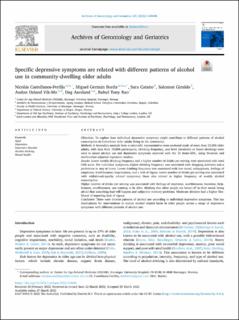| dc.contributor.author | Castellanos-Perilla, Nicolás | |
| dc.contributor.author | Borda, Miguel Germán | |
| dc.contributor.author | Cataño, Sara | |
| dc.contributor.author | Giraldo, Salomon | |
| dc.contributor.author | Vik-Mo, Audun Osland | |
| dc.contributor.author | Aarsland, Dag | |
| dc.contributor.author | Rao, Rahul Tony | |
| dc.date.accessioned | 2023-01-26T08:33:25Z | |
| dc.date.available | 2023-01-26T08:33:25Z | |
| dc.date.created | 2022-05-01T14:44:56Z | |
| dc.date.issued | 2022 | |
| dc.identifier.citation | Castellanos-Perilla, N., Borda, M. G., Cataño, S., Giraldo, S., Vik-Mo, A. O., Aarsland, D., & Rao, R. T. (2022). Specific depressive symptoms are related with different patterns of alcohol use in community-dwelling older adults. Archives of gerontology and geriatrics, 101, 104696. | en_US |
| dc.identifier.issn | 0167-4943 | |
| dc.identifier.uri | https://hdl.handle.net/11250/3046460 | |
| dc.description.abstract | Objectives
To explore how individual depressive symptoms might contribute to different patterns of alcohol consumption in Colombian older adults living in the community.
Methods
A Secondary analysis from a nationally representative cross-sectional study of more than 23,000 older adults, with data from 19,004 participants. Drinking frequency, and level (moderate or heavy drinking) were used to assess alcohol use and depressive symptoms explored with the 15 items-GDS., using bivariate and multivariate adjusted regression models.
Results
Lower weekly drinking frequency and a higher number of drinks per serving were associated with total GDS score. For individual symptoms, higher drinking frequency was associated with dropping activities and a preference to stay at home. Lower drinking frequency was associated with low mood, unhappiness, feelings of emptiness, worthlessness, hopelessness, and a lack of vigour. Lower number of drinks per serving was associated with withdrawal/apathy related symptoms; these also related to higher frequency of weekly alcohol consumption.
Higher number of drinks per serving was associated with feelings of emptiness, worthlessness, boredom, helplessness, worthlessness. not wanting to be alive, thinking that other people are better off in their mood, being afraid that something bad will happen and subjective memory problems. Moderate drinkers had a higher likelihood of reporting lack of vigour.
Conclusion
There were diverse patterns of alcohol use according to individual depressive symptoms. This has implications for interventions to reduce alcohol related harm in older people across a range of depressive symptoms with different patterns of alcohol use. | en_US |
| dc.language.iso | eng | en_US |
| dc.publisher | Elsevier | en_US |
| dc.rights | Navngivelse 4.0 Internasjonal | * |
| dc.rights.uri | http://creativecommons.org/licenses/by/4.0/deed.no | * |
| dc.title | Specific depressive symptoms are related with different patterns of alcohol use in community-dwelling older adults | en_US |
| dc.title.alternative | Specific depressive symptoms are related with different patterns of alcohol use in community-dwelling older adults | en_US |
| dc.type | Peer reviewed | en_US |
| dc.type | Journal article | en_US |
| dc.description.version | publishedVersion | en_US |
| dc.rights.holder | The author | en_US |
| dc.subject.nsi | VDP::Medisinske Fag: 700 | en_US |
| dc.source.volume | 101 | en_US |
| dc.source.journal | Archives of gerontology and geriatrics (Print) | en_US |
| dc.identifier.doi | 10.1016/j.archger.2022.104696 | |
| dc.identifier.cristin | 2020431 | |
| cristin.ispublished | true | |
| cristin.fulltext | original | |
| cristin.qualitycode | 1 | |

